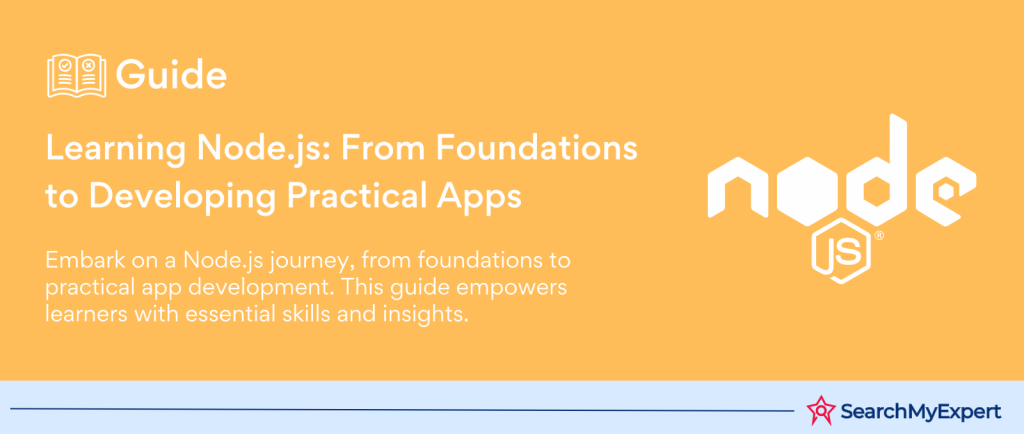What is Node.js? An In-depth Introduction
Definition and Core Concepts
Node.js is an open-source, cross-platform JavaScript runtime environment that executes JavaScript code outside a web browser. This powerful tool has revolutionized the way developers build web applications, enabling JavaScript to run on the server side. Built on Google Chrome’s V8 JavaScript engine, Node.js is designed to build scalable network applications with efficiency and speed.
Key Features of Node.js
Node.js is renowned for its event-driven, non-blocking I/O architecture, making it exceptionally well-suited for building fast, scalable network applications. Below are some of the key features that make Node.js stand out:
- Event-Driven: Every action on a Node.js server is a non-blocking operation. This means that Node.js uses events as the core of its architecture, enabling it to handle multiple connections simultaneously without incurring the cost of thread context switching.
- Non-Blocking I/O Architecture:
Node.js processes operations asynchronously, avoiding the performance bottlenecks associated with traditional synchronous I/O operations. This feature is particularly useful for applications that require heavy I/O operations, such as file systems, networks, or databases. - Single-Threaded with Worker Threads: While Node.js operates on a single-thread model for event looping, it also offers the capability of worker threads. This model facilitates concurrent execution of JavaScript code, ensuring that non-blocking operations are executed in the background, thus maintaining high performance.
- JavaScript Everywhere:
Node.js extends the reach of JavaScript, traditionally a front-end development language, to the server side. This unification allows developers to use a single programming language across the entire development stack, simplifying the development process and reducing the learning curve for new developers.
Target Audience
Node.js caters to a wide range of professionals in the technology sector, including:
- Web Developers:
Node.js is a go-to choice for developers looking to build fast, scalable web applications, especially single-page applications (SPAs), real-time applications (RTAs), and RESTful APIs. - Mobile App Developers:
With the rise of hybrid mobile app development, Node.js serves as a robust back-end solution that can handle mobile app services and APIs efficiently. - IoT Developers:
Node.js’s lightweight and efficient nature of Node.js makes it ideal for developing Internet of Things (IoT) applications, where managing multiple concurrent connections efficiently is crucial. - System Administrators: Node.js is also beneficial for system administrators looking to automate tasks, build tools, or develop network programs.
- Data Scientists: Although not the primary audience, data scientists can leverage Node.js for building lightweight web applications or dashboards to display and interact with data analysis results.
Understanding Node.js’s Impact
Node.js’s non-blocking, event-driven architecture offers a paradigm shift from traditional web server technology. Its ability to handle thousands of concurrent connections on a single server without resorting to multi-threading reduces overhead and enhances performance. This makes Node.js an excellent choice for developing high-traffic, data-intensive applications, such as online gaming platforms, chat applications, and live streaming services.
Additionally, the Node.js ecosystem is supported by a vast and active community, contributing to a rich library of modules and tools available through npm, the Node.js package manager. This ecosystem accelerates development and encourages innovation and collaboration among developers.
Why Use Node.js? Unveiling
Its Advantages and Applications
Node.js has emerged as a powerhouse in the development world, thanks to its unique features and benefits. Understanding why developers choose Node.js over other technologies is crucial in grasping its growing popularity and widespread adoption. Below, we explore the benefits of Node.js and its diverse use cases, shedding light on why it stands out from traditional web technologies and other JavaScript environments.
Benefits of Using Node.js
Node.js offers a plethora of advantages that cater to the needs of modern web development, making it a preferred choice for developers worldwide.
Fast and Scalable
- Non-Blocking I/O Model:
Node.js’s event-driven architecture allows it to handle multiple connections simultaneously, making it incredibly fast and highly scalable. This capability is especially beneficial for applications that require real-time operations and high levels of concurrency. - V8 JavaScript Engine:
Leveraging Google Chrome’s V8 engine, Node.js executes JavaScript at lightning speeds, translating JavaScript code into machine code more efficiently. This enhances the overall performance and responsiveness of applications built with Node.js.
Efficient and Versatile
- Cross-Platform Development: Node.js facilitates the development of cross-platform applications, enabling code to run seamlessly on various operating systems. This versatility reduces development time and effort, as developers can use the same codebase for server-side and client-side components.
- Wide Range of Applications:
From web servers to real-time applications and IoT devices, Node.js’s efficiency and versatility make it suitable for a broad spectrum of applications, further discussed in the use cases section below.
Large Community and Rich Ecosystem
- Vibrant Community: Node.js boasts a large and active community of developers who contribute to its continuous improvement and extension. This community support ensures that developers have access to timely help and resources.
- Rich Ecosystem of Tools and Libraries: Thanks to npm, Node.js’s package manager, developers have at their disposal an extensive ecosystem of libraries and tools. This ecosystem simplifies the addition of new functionalities and accelerates the development process.
Use Cases of Node.js
Node.js’s flexibility and efficiency have paved the way for its application across various domains:
- Web Servers (HTTP, WebSockets):
Node.js is ideal for developing lightweight and efficient web servers, supporting both traditional HTTP and real-time WebSocket connections. - Real-Time Applications (Chat, Multiplayer Games):
Its
event-driven architecture makes Node.js perfect for building real-time applications, such as chat applications and multiplayer online games, where low latency and high concurrency are essential. - Data Streaming:
Node.js’s streams API facilitates the processing of data streams, such as video or audio streams, efficiently and in real-time, making it a go-to choice for media streaming applications. - Microservices: The lightweight nature of Node.js aligns well with the microservices architecture, allowing for the development of scalable and independently deployable microservices.
- Command-Line Tools:
Node.js can be used to create powerful command-line tools and utilities, thanks to its fast execution time and the ease of scripting with JavaScript. - Internet of Things (IoT):
For IoT applications, the non-blocking I/O model and lightweight runtime of Node.js are highly advantageous for handling a large number of simultaneous connections with low resource consumption.
Installing and Setting Up Node.js: A Step-by-Step Guide
Embarking on your journey with Node.js begins with its installation and setting up your development environment. This foundational step is crucial, irrespective of whether you are on Windows, macOS, or Linux. Let’s navigate through the process of installing Node.js, ensuring your system is ready for development, and establishing a basic project structure.
Installation Across Different Platforms
Windows, macOS, and Linux
Node.js accommodates all major operating systems by offering downloadable binaries and support through package managers, making it accessible to a diverse range of developers.
- For Windows and macOS Users: The Node.js website provides an easy-to-use installer that guides you through the setup process. This installer is tailored to your specific operating system, simplifying the installation process.
- For Linux Users:
Linux enthusiasts can leverage the power of package managers to install Node.js. This method varies slightly depending on the Linux distribution but generally involves a simple command line operation. Additionally, downloadable binaries are available for those who prefer a more manual approach.
Utilizing Package Managers
Beyond the basic installation, developers have the option to use version managers such as nvm (Node Version Manager). This tool is especially useful for managing multiple Node.js versions, allowing you to switch contexts between projects effortlessly.
Verifying the Installation
After installation, it’s essential to confirm that Node.js and npm (Node Package Manager), its companion tool for managing packages, are correctly installed. This verification can be done by checking their versions. A successful installation will return the versions, indicating that both Node.js and npm are ready for use.
Understanding Package Management
Node.js introduces developers to a rich ecosystem of libraries and tools through npm, the default package manager. npm is a gateway to thousands of packages, facilitating the addition of new functionalities to your projects. For those looking for an alternative, yarn presents itself as a capable substitute, offering faster dependency resolution and efficient caching. Both npm and yarn connect to the npm registry, providing access to a vast repository of resources.
Setting Up a Basic Project Structure
A well-organized project structure is key to a smooth development process. The cornerstone of any Node.js project is the package.json file, which holds vital information about your project and its dependencies. This file is created at the beginning of your project and evolves as you add more packages.
Organizing Your Directory
A typical Node.js project might include a src directory for your source files, signifying the heart of your project. You might also create directories for libraries, utilities, and tests, each serving a specific purpose in your development workflow. This organized approach ensures that your project remains manageable and scalable.
Managing Dependencies
Your package.json file plays a crucial role in managing the dependencies your project requires. These dependencies are libraries or packages that your project depends on. Managing these dependencies efficiently is crucial for the development and deployment of your project.
Running Your First Node.js Script: Embarking on the Node.js Journey
Stepping into the world of Node.js, one of the initial milestones any aspiring developer encounters is running their first script. This foundational exercise, typically a “Hello World” program, is much more than a rite of passage. It serves as an essential check to ensure your setup is correctly configured and introduces you to the fundamental operations within Node.js. Let’s delve into creating a “Hello World” program, understanding the function that enables us to print messages to the console, and learning how to run the script.
Creating the “Hello World” Program
The journey begins with crafting a simple JavaScript program designed to output “Hello World”. This task involves writing a minimal piece of code that, when executed, displays the message to the console. The essence of this program lies in its simplicity, offering a straightforward introduction to scripting in Node.js.
The Role of console.log
Central to our “Hello World” program is the console.log function, a fundamental tool in the JavaScript and Node.js development arsenal. This function is instrumental in printing messages to the console, a critical feature for debugging and providing real-time feedback during development. Through console.log, developers gain visibility into their code’s behavior, making it an indispensable method for beginners and seasoned programmers alike.
Executing Your Script
With the “Hello World” script at the ready, the next step is to bring it to life by running it through Node.js. This process involves a few simple actions within the command line or terminal, an interface that allows for direct communication with your computer’s operating system through typed commands.
Running the Script with Node.js
To execute the script, you’ll navigate to the directory containing your script using the terminal or command prompt. This step is crucial as it positions you within the correct context to run the Node.js command. Following this, you’ll initiate the execution of your script by invoking Node.js, followed by the name of your script file. This action instructs Node.js to process the JavaScript code contained within the file, resulting in the display of “Hello World” in the console.
Core Node.js Modules and Concepts: Foundations for Efficient Development
Diving deeper into Node.js, it’s essential to grasp the core modules and fundamental concepts that make it a powerful and efficient platform for developing scalable applications. From the event-driven architecture to the modular system of organizing code, these elements are the backbone of Node.js’s design philosophy. Understanding these will enable you to harness the full potential of Node.js in your projects.
The Event Loop: Mastering Asynchronous Operations
At the heart of Node.js lies the event loop, a single-threaded, non-blocking I/O model that allows Node.js to handle multiple concurrent requests efficiently. Unlike traditional multi-threaded server models, Node.js’s event loop enables it to perform non-blocking operations, meaning it can process other tasks while waiting for I/O operations to complete. This architecture is key to Node.js’s ability to manage high volumes of requests without the overhead of thread management.
Embracing Asynchronous Programming: Callbacks and Promises
Node.js embraces asynchronous programming, primarily through callbacks and promises, to handle operations that don’t yield results immediately.
- Callbacks: Initially, Node.js relied heavily on callbacks for asynchronous operations. A callback is a function passed as an argument to another function, which is then executed once the operation completes. While effective, excessive use of callbacks can lead to “callback hell,” making code difficult to read and maintain.
- Promises:
Introduced as a solution to callback hell, promises represent the eventual completion (or failure) of an asynchronous operation and its resulting value. Promises allow developers to write cleaner, more manageable code by using .then() for success scenarios and .catch() for handling errors.
Modules: The Building Blocks of Node.js Applications
Modules are fundamental to code organization in Node.js, allowing developers to divide their programs into separate blocks of functionality. This modular approach not only enhances code readability and maintenance but also facilitates reuse across projects.
- Importing and Exporting Modules: Node.js uses the required function to import modules into a file, enabling access to their functionalities. Conversely, modules can export their functions, objects, or variables using the module. exports, making them available for use in other files.
Building a Simple HTTP Server with Node.js: A Step-by-Step Guide
Embarking on the development of a simple HTTP server in Node.js is a practical exercise that reinforces understanding of its core modules and asynchronous programming paradigms. Utilizing the HTTP module, one of Node.js’s foundational core modules, you’ll see firsthand how Node.js handles web requests and responses, serving as a powerful platform for web development. This guide will walk you through creating a basic HTTP server, handling requests, serving static files, and implementing best practices for debugging and testing.
Creating an HTTP Server
The journey begins with the HTTP module, which provides the necessary tools to create an HTTP server. This server will listen for incoming requests on a specified port, processing and responding to each request accordingly.
Listening to Incoming Requests and Responding
The essence of an HTTP server in Node.js involves invoking the createServer method from the HTTP module. This method expects a request listener function that takes two arguments: the request (req) and the response (res). Inside this function, you define how the server should handle incoming requests and construct responses.
Handling Requests with Callbacks or Promises
Node.js’s asynchronous nature is showcased in how requests are handled. You can implement request handlers using either callbacks or Promises, depending on your preference for managing asynchronous operations. This flexibility allows you to write clean, efficient code that responds to various endpoints or request types, such as GET and POST.
Serving Static Files: HTML, CSS, JavaScript
A common requirement for HTTP servers is the ability to serve static files, such as HTML pages, CSS stylesheets, and JavaScript files. This involves setting up your server to read and send these files as responses to appropriate requests. Utilizing the fs (File System) module, your server can read the contents of a requested file and return it as part of the HTTP response, properly setting the Content-Type header to match the type of the static file being served.
Beyond the Basics: Elevating Your Node.js Journey
Having laid the groundwork with the fundamentals of Node.js, from setting up a basic HTTP server to understanding its core modules and event-driven architecture, it’s time to venture beyond the basics. The path forward involves exploring the vast ecosystem of libraries, frameworks, and tools that extend Node.js’s capabilities, as well as deepening your JavaScript knowledge and applying your skills to build real-world applications. This journey will not only enhance your technical proficiency but also open up new possibilities for innovation and development.
Exploring Libraries, Frameworks, and Tools
The Node.js ecosystem is rich with libraries and frameworks that simplify web development, enhance functionality, and streamline the development process.
- Express.js: Among the most popular frameworks for Node.js, Express.js offers a robust set of features for web and mobile applications, making it simpler to build APIs and web servers.
- Socket.io: For real-time applications, such as chat apps or live notifications, Socket.io enables event-based communication between web clients and servers.
- Mongoose:
When working with MongoDB, Mongoose provides a schema-based solution to model your application data, offering built-in type casting, validation, query building, and business logic hooks. - Passport:
For authentication, Passport.js is a comprehensive set of strategies that support authentication using a username and password, Facebook, Twitter, and more.
Exploring these tools and understanding their use cases can significantly impact your development workflow and the quality of your applications.
Learning JavaScript Deeply
A profound understanding of JavaScript is crucial for effective Node.js development. This involves mastering core concepts, asynchronous programming, and best practices.
- Core Concepts: Dive into JavaScript’s core concepts, including closures, prototypes, and ES6+ features like classes, modules, and arrow functions.
- Asynchronous Programming:
Deepen your understanding of asynchronous programming by exploring callbacks, promises, async/await, and managing control flow in complex applications. - Best Practices:
Adopt best practices such as writing clean, readable code; implementing error handling and logging; and understanding memory management and performance optimization.
Building Real-World Applications
Applying what you’ve learned by building real-world applications is the best way to consolidate your knowledge and skills.
- Web APIs:
Develop RESTful APIs or GraphQL APIs that serve as the backend for web applications, providing structured access to resources and data. - Data Streaming:
Implement applications that process data streams, useful in scenarios like real-time analytics, log processing, or media streaming. - Microservices:
Architect your applications as a collection of loosely coupled services, which allows for more scalable and maintainable systems. - IoT Projects:
With Node.js’s lightweight and efficient runtime, it’s suited for building Internet of Things (IoT) applications, and managing and processing data from sensors and devices.
Conclusion:
As we wrap up this extensive guide on Node.js, we’ve traversed from understanding the basics and core modules of Node.js to setting up a simple HTTP server, and further into exploring the vibrant ecosystem of libraries and frameworks. We’ve underscored the importance of deep JavaScript knowledge and its application in developing real-world projects. Whether your interest lies in creating efficient web APIs, engaging in data streaming, architecting microservices, or innovating within the IoT space, the versatility and efficiency of Node.js stand out as the backbone of modern web development.
The journey doesn’t end here. The landscape of Node.js is ever-evolving, with an active community constantly pushing the boundaries of what’s possible. Engaging with this community, staying abreast of the latest developments, and continuously experimenting will not only enhance your skills but also keep you at the forefront of technology innovation.
Redefine your web applications with Node JS Development Service Firms.
Table of Contents
Toggle






